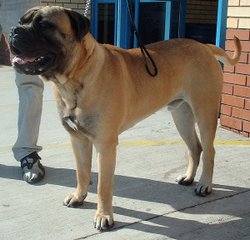
|
Dog breeds of the world, Bullmastiff |
| Bullmastiff | ||
|---|---|---|

|
||
| Alternative names | ||
| Country of origin | ||
| United Kingdom | ||
| Common nicknames | ||
| Classification and breed standards | ||
| FCI: | Group 2 Section 2 #157 | |
| AKC: | Working | |
| ANKC: | Group 6 (Utility) | |
| CKC: | Group 3 - Working Dogs | |
| KC (UK): | Working | |
| NZKC: | Utility | |
| UKC: | Guardian Dogs | |
| Not recognized by any major kennel club | ||
| This breed of Dog is extinct | ||
| Notes | ||
The Bullmastiff is a powerful Dog, said to be a cross between the Mastiff and the BullDog. Originally bred to find and immobilise poachers, the breed has proved its value as a family pet.
This breed resembles the Boerboel and English Mastiff or a larger version of the Boxer. It is powerfully built and symmetrical, showing great strength, but not cumbersome; it is sound and active.
The Bullmastiff is a relatively large Dog. The American Bullmastiff Association standard calls for Dogs to be between 25 and 27 in (635 and 686 mm) tall at the withers and between 110 and 130 lb (50 and 60 kg) though current judging trends often favour a Dog slightly larger than this. Bitches are to be between 23 and 26 in (600 to 650 mm) tall and 100 to 120 lb (45 to 55 kg). Some dams make good mothers, but elective Caesarian sections are common, and most breeding is quite costly as a result. An average litter size is about six, but as few as one and as many as ten are not unheard of.
Any shade of brindle, fawn, or red is allowed as long as the colour is pure and clear. The fawn is a light tan or blond color, while the red is a richer, red-brown. This can range from a deep red to a light red merging with the fawn sometimes described as a red-fawn. A slight white marking on the chest is permissible, but other white markings are undesirable. A black muzzle is essential, toning off towards the eyes, with dark markings around eyes contributing to the expression.
With its handsome, powerful appearance and superb speed coupled with strength and endurance, it can overtake and capture intruders without mauling them. These traits make the Bullmastiff appear to be an excellent choice for a guard Dog; however, a stubborn streak makes the animal somewhat resistant to obedience training and they can be overly protective of its human family. Due to this, the breed has been overtaken by others, more popular as guard Dogs. Bred to sneak up on poachers, the Bullmastiff often barks much less than other breeds, but when they bark they will make your head turn, as it is dark and hollow sounding. The Bullmastiff was recognised as a pure-bred Dog in 1924 by the English Kennel Club. In October, 1933, The American Kennel Club recognised the Bullmastiff. The foundation breeding was 60% Mastiff and 40% BullDog (which was more like the American BullDog not the short English BullDog of today).
This Dog was popularized by the media in Canada in the late 1990s as being the breed of Dog in a string of (unrelated) Dog attacks against children. The proposal to ban the breed in Canada started a small uprising and the measure ultimately failed.
Bullmastiffs are sometimes crossbred with Pit Bulls for strength.The offspring are known as Pitbuulmastiffs and nowadays,purebred pitbullmastiffs are available. Bullmastiffs are also crossed with Rottweilers to improve trainability.
Dog breeds of the world, Bullmastiff